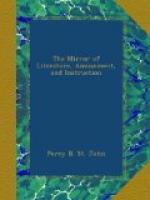The author goes on to remark, “that the decline in the mortality is even more striking in our cities than in our rural districts. While the metropolis has extended itself in all directions, and multiplied its inhabitants to an enormous amount,—in other words, while the seeming sources of its unhealthiness have been largely augmented, it has actually become more friendly to health.” In the middle of the last century, the annual mortality was about 1 in 20. By the census of 1821, it appeared as 1 in 40: so that in the space of seventy years, the chances of existence are exactly doubled in London,—a progress and final result, adds the author, without a parallel in the history of any other age or country. The high rate of mortality in London about the year 1750, exceeding considerably that of former years, has been attributed to the great, abuse of spirituous liquors, which were then sold without the very necessary check of high duties. One of the results of these statistical investigations which, a priori, we should least have been prepared for, is the uncommon healthiness of Manchester. The rate of mortality there at the present time does not appear to exceed 1 in 74.
The statistics of the sexes afford some curious results. The relative numbers of the sexes are the same in all parts of the world,—namely, at birth, twenty-one males to twenty females, but as the mortality among males during infancy exceeds that of females, the sexes at the age of fifteen are nearly equal. A late French writer, M. Giron, thinks himself warranted in the opinion, that agricultural pursuits favour an increase in the male, while commerce and manufactures encourage the female population. There exists throughout the world considerable variety in the proportion of births to marriages, but, upon an average, we may state it at about four to one. It has been uniformly found, however, that improvements in the public health are attended by a diminution of marriages and births. The great principle is this: as the number of men cannot exceed their means of subsistence, if men live longer, a less number is born, and the human race is maintained at its due complement with fewer deaths and fewer births, a contingency favourable in every respect to happiness. The author illustrates this very important principle by the population returns both of England and France.
* * * * *




